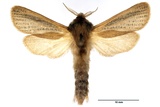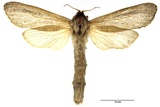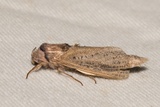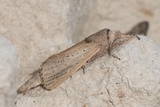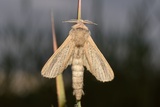Phragmataecia castaneae (Hübner, 1790) Species
Last modified: Oct. 2, 2025, 1:01 p.m.
A very rare and local species in Belgium, mainly found in the northern part and especially in the Kempen region.
This species is considered Vulnerable according to the IUCN Red List category for Flanders 2023.
Details
- Classification
- Family: Cossidae > Subfamily: Zeuzerinae > Genus: Phragmataecia > Species: Phragmataecia castaneae
- Vernacular names
- Rietluipaard (NL), Reed Leopard (EN), Zeuzère du roseau (FR), Rohrbohrer, Schilfrohrbohrer (DE)
- First mention in Belgium
- Derenne F. 1934b. Espèces nouvelles pour la faune belge (suite). — Lambillionea 34: 222–223. On page 223.
- Status
-
Native
Distribution
Genitalia
Male: uncus elongated with pointed apex; gnathos reduced; valva narrow, semilanceolate, broadly rounded distally; juxta somewhat hexagonal with short lateral tubercle like extensions; saccus relatively wide, broadly rounded distally; phallus longer than valva, slender, slightly c-shaped; vesica without cornuti.
Bionomics
The larva bores in the lower part of the culm and development takes two years. Pupation in the spring in the upper part of the culm.
The adult moths come to light.
Flight periods
The adults have been seen from mid-May till mid-September with a peak during June.
Observed on
- Host plant (species):
- Phragmites australis
The monophagous larva feeds on the stems of Phragmites australis.
Habitat
It inhabits fens, marshes, reedswamps and reedbeds.
